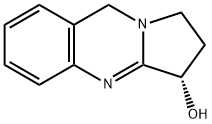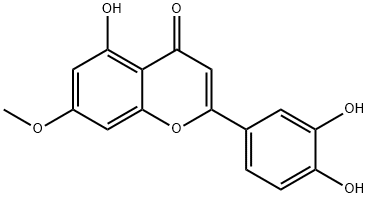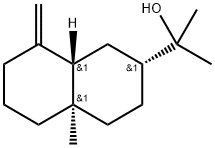Vasicine
- CAS NO.:6159-55-3
- Empirical Formula: C11H12N2O
- Molecular Weight: 188.23
- MDL number: MFCD01544498
- EINECS: 228-180-8
- SAFETY DATA SHEET (SDS)
- Update Date: 2024-04-01 18:08:31

What is Vasicine?
Description
This quinazoline alkaloid was first isolated from the leaves of Adhatoda vasica
Nees by Hooper and subsequently discovered in Peganum harmala under the
name Peganine. The base is optically inactive although Spath and Kesztler have
reported the isolation of the (-)-form from the fresh leaves of A. vasica and
Rosenfeld and Kolesnikow have obtained the same form from the flowers and
stems of Peganum harmala. The salts are readily obtained crystalline, e.g. the
hydrochloride dihydrate, m.p. 208°C (dry); hydriodide dihydrate, m.p. 195°C
(dry); picrate, m.p. 199°C (dec.) and the methiodide, m.p. 187°C.
With AcOH, the alkaloid gives an anomalous acetyl derivative, m.p. 165°C,
subsequently shown to be N-acetylpedadiene. Oxidation with KMn04 gives
4-quinazolone and 4-keto-3 :4-dihydroxyquinazolyl-3-acetic acid, the latter
characterized as the methyl ester, m.p. 152°C.
The crude drug from A. vasica is used in India as a remedy for asthma while
the pure alkaloid acts as a bronchodilator.
Chemical properties
White needle-like crystals, soluble in organic solvents such as methanol, ethanol, DMSO, etc., derived from camels.
Biological Activity
Vasicine, isolated from A. vasica, is an alkaloid. It is a natural cholinesterase (cholinesterase) inhibitor, has anticholinesterase activity in preclinical models, and can be used for the development of therapeutic drugs for Alzheimer's disease.
References
Hooper., Pharm. J., 18,841 (1888)
Sen, Ghose.,J. Ind. Chem. Soc., 1,315 (1924)
Ghose., ibid, 4, 1 (1927)
Spath, Nakawitz., Ber., 67,45 (1934)
Spath, Kuffner., ibid, 67, 1494 (1934)
Narang, Ray., Chem. & Ind., 53,698 (1934)
Hanford, Liang, Adams., J. Amer. Chem. Soc., 56, 2780 (1934)
Ghoseetal., ibid, 57,921,951 (1935)
Rosenfeld, Kolesnikov., Ber., 69, 2022 (1936)
Pharmacology:
Chopra., Ind. Med. Gaz., 60, 354 (1925)
Tutaev, Makarova., Trans. Ukraine Inst. Exp. Pharm., 1,32 (1938)
Properties of Vasicine
| Melting point: | 211.5°C |
| Boiling point: | 323.23°C (rough estimate) |
| Density | 1.1124 (rough estimate) |
| refractive index | 1.5850 (estimate) |
| solubility | DMSO : 83.33 mg/mL (442.70 mM; Need ultrasonic) |
| form | Powder |
| pka | 13.08±0.20(Predicted) |
Safety information for Vasicine
| Signal word | Warning |
| Pictogram(s) |
 Exclamation Mark Irritant GHS07 |
| GHS Hazard Statements |
H302:Acute toxicity,oral H315:Skin corrosion/irritation H319:Serious eye damage/eye irritation H335:Specific target organ toxicity, single exposure;Respiratory tract irritation |
| Precautionary Statement Codes |
P261:Avoid breathing dust/fume/gas/mist/vapours/spray. P305+P351+P338:IF IN EYES: Rinse cautiously with water for several minutes. Remove contact lenses, if present and easy to do. Continuerinsing. |
Computed Descriptors for Vasicine
New Products
Tert-butyl bis(2-chloroethyl)carbamate (S)-3-Aminobutanenitrile hydrochloride N-Boc-D-alaninol N-BOC-D/L-ALANINOL 3-(2,4-Dimethoxybenzyl)dihydropyrimidine-2,4(1H,3H)-dione 6-Bromo-3-iodo-1-methyl-1H-indazole N-octanoyl benzotriazole 3,4-Dibenzyloxybenzaldehyde 4-Hydrazinobenzoic acid Electrolytic Iron Powder 1,1’-CARBONYLDIIMIDAZOLE R-2-BENZYLOXY PROPIONIC ACID 4-HYDROXY BENZYL ALCOHOL 1,1’-CARBONYLDI (1,2-4 TRIAZOLE) S-2-CHLORO PROPIONIC ACID (2-Hydroxyphenyl)acetonitrile 4-Bromopyrazole 5-BROMO-2CYANO PYRIDINE 5,6-Dimethoxyindanone 5-broMo-2-chloro-N-cyclopentylpyriMidin-4-aMine N-Boc-L-proline methyl ester 2-(BOC-Amino)4-picoline 1-(4-Methylphenylsulfonyl)-1H-1,2,3-benzotriazole 1-(2-Chlorobenzyl)-4-nitro-1H-pyrazoleRelated products of tetrahydrofuran







![(R)-1,2,3,9-TETRAHYDRO-PYRROLO[2,1-B]QUINAZOLIN-3-OL](https://img.chemicalbook.in/StructureFile/ChemBookStructure21/GIF/CB3785205.gif)
You may like
-
 55441-95-7 2 2-BIS(2-HYDROXYETHOXY)-1 1-BINAPHTHYL 99%View Details
55441-95-7 2 2-BIS(2-HYDROXYETHOXY)-1 1-BINAPHTHYL 99%View Details
55441-95-7 -
 181228-33-1 99%View Details
181228-33-1 99%View Details
181228-33-1 -
 Ste-Glu-AEEA-AEEA-OSUView Details
Ste-Glu-AEEA-AEEA-OSUView Details
1169630-40-3 -
 1446013-08-6 Fmoc-His-Aib-OH TFA 98%View Details
1446013-08-6 Fmoc-His-Aib-OH TFA 98%View Details
1446013-08-6 -
 127464-43-1 99%View Details
127464-43-1 99%View Details
127464-43-1 -
 Chloro Uracil 99%View Details
Chloro Uracil 99%View Details
1820-81-1 -
 2-ETHYLPYRIDINE 100-71-0 99%View Details
2-ETHYLPYRIDINE 100-71-0 99%View Details
100-71-0 -
 13162-05-5 99%View Details
13162-05-5 99%View Details
13162-05-5